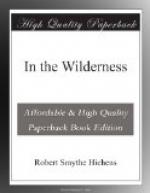Shortly came a sound that threw the doe into a panic of terror,—a short, sharp yelp, followed by a prolonged howl, caught up and reechoed by other bayings along the mountain-side. The doe knew what that meant. One hound had caught her trail, and the whole pack responded to the “view-halloo.” The danger was certain now; it was near. She could not crawl on in this way: the dogs would soon be upon them. She turned again for flight: the fawn, scrambling after her, tumbled over, and bleated piteously. The baying, emphasized now by the yelp of certainty, came nearer. Flight with the fawn was impossible. The doe returned and stood by it, head erect, and nostrils distended. She stood perfectly still, but trembling. Perhaps she was thinking. The fawn took advantage of the situation, and began to draw his luncheon ration. The doe seemed to have made up her mind. She let him finish. The fawn, having taken all he wanted, lay down contentedly, and the doe licked him for a moment. Then, with the swiftness of a bird, she dashed away, and in a moment was lost in the forest. She went in the direction of the hounds.
According to all human calculations, she was going into the jaws of death. So she was: all human calculations are selfish. She kept straight on, hearing the baying every moment more distinctly. She descended the slope of the mountain until she reached the more open forest of hard-wood. It was freer going here, and the cry of the pack echoed more resoundingly in the great spaces. She was going due east, when (judging by the sound, the hounds were not far off, though they were still hidden by a ridge) she turned short away to the north, and kept on at a good pace. In five minutes more she heard the sharp, exultant yelp of discovery, and then the deep-mouthed howl of pursuit. The hounds had struck her trail where she turned, and the fawn was safe.




